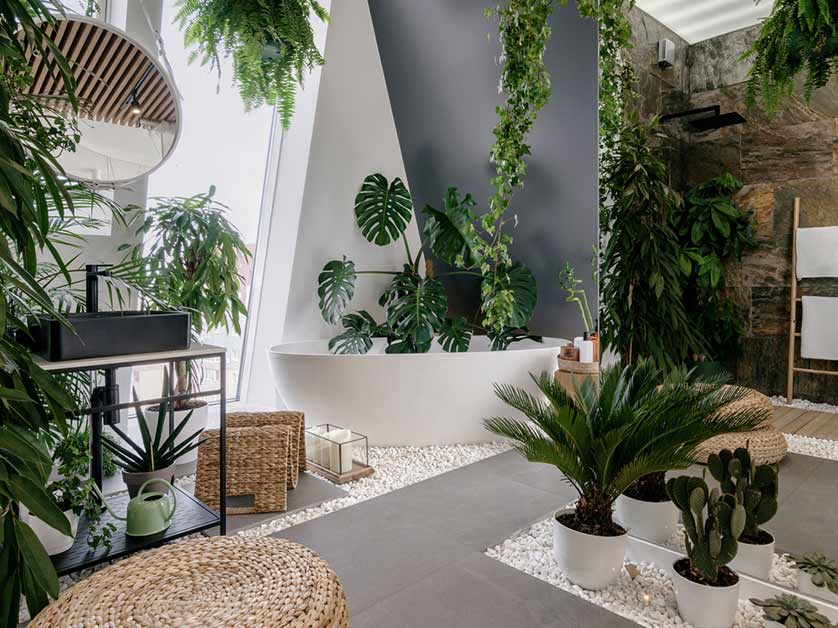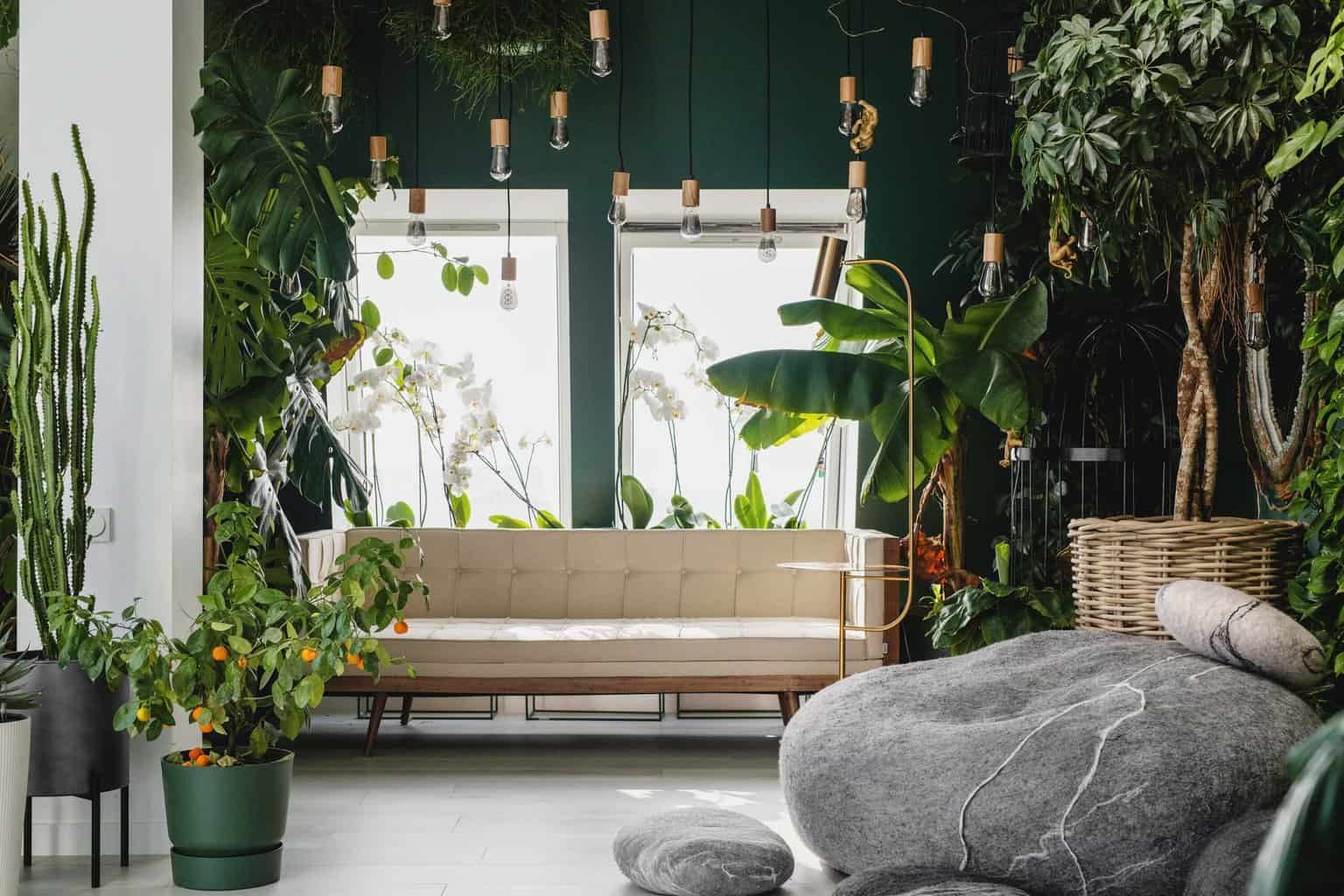Have you ever noticed you feel calmer and more refreshed in a room with plenty of natural light, plants and earthy textures? That’s the magic of biophilic design — a philosophy that focuses on bringing the outdoors into your home.
What Is Biophilic Home Design?
Biophilia means “love of life” or “love of living systems.” Biophilic design applies this concept to built environments by integrating natural elements, materials and patterns into indoor spaces. Humans have an innate connection to nature, and maintaining this relationship in your home can improve your well-being.
The idea isn’t new — cultures throughout history have incorporated natural elements into their living spaces. However, as urbanization increased and technology advanced, many people began spending more time indoors, disconnected from the world outside their doors. Biophilic design bridges this gap by bringing elements of nature back into daily life.
10 Fundamental Elements of Biophilic Home Design
Biophilic home design should inspire you to design spaces that nurture your wellness and find harmony within your environment.
1. Abundant Natural Light
Large windows, skylights and glass doors flood a space with sunlight and create visual connections to the outdoors. Natural light regulates your circadian rhythm, improves your mood and makes your house feel larger and more inviting.
2. Indoor Plants
Perhaps the most obvious way to introduce biophilia is to bring in houseplants to purify the air, add color and create a direct connection to living things. From small succulents to statement floor plants, there’s a plant for every space and light condition. Even if you lack a green thumb, low-maintenance options like snake plants or ZZ plants can thrive with minimal care.
3. Natural Materials
Incorporating wood, stone, bamboo and other natural materials adds warmth and texture while creating a sensory connection to nature. Wooden furniture, stone countertops and natural fiber rugs all contribute to a biophilic space. These materials age beautifully and often have unique patterns with charming irregularities.
4. Nature’s Colors
Earth tones like greens, browns, blues and sandy neutrals mimic colors found in nature and create a calming atmosphere. Incorporate these colors through paint, textiles or accessories. Even small pops of these hues can improve your mood.
5. Water Features
The sound and sight of water can be incredibly soothing. Indoor fountains, small water features and fish tanks can add sensory richness to your home. Gently bubbling, flowing water creates white noise that masks less pleasant sounds and promotes relaxation.
6. Natural Patterns and Shapes
Transform your space by incorporating designs that reflect patterns found in nature, such as honeycomb shapes, leaf motifs or fractal patterns. These can appear in textiles, artwork or architectural elements. Our brains instinctively recognize and respond positively to these patterns, making them aesthetically pleasing and psychologically beneficial.
7. Outdoor Views
Designing a space to maximize views of nature, whether it’s a garden, trees or the sky, creates a connection. If natural views aren’t available, artwork depicting nature scenes can serve as a substitute. Strategically place furniture to make these a daily focal point.
8. Natural Ventilation
Fresh air is vital for your well-being. Operable windows, ceiling fans and cross-ventilation systems improve air quality and create subtle air movement that mimics outdoor environments. The feeling of a gentle breeze can make indoor spaces feel more connected to the outside world.
9. Varied Textures
Incorporating a mix of textures that invite touch and create sensory diversity enriches a space. Think rough stone, smooth wood, soft textiles and tactile plants. Close to 70% of design experts point to natural wood as one of the most popular finishes. These contrasting textures create a rich sensory experience that’s missing from many modern, homogenous interiors.
10. Dynamic and Diffused Light
Beyond maximizing natural light, consider how light changes throughout the day. Dappled light through plants or sheer curtains creates beautiful, changing patterns reminiscent of sunshine filtering through trees. This dynamic quality adds visual interest and a connection to natural rhythms.
Advantages of Biophilic Design

Biophilic design offers a multitude of benefits, enhancing your health and sustainability by seamlessly integrating nature into your home.
1. Reduced Stress and Anxiety
Exposure to natural elements lowers cortisol levels and reduces feelings of stress and anxiety. Even brief interactions with nature or natural elements can have a calming effect on your nervous system.
2. Improved Air Quality
Plants naturally filter air by absorbing carbon dioxide and releasing oxygen. Many varieties also remove common indoor pollutants. When combined with natural ventilation, houseplants can significantly improve your home’s air quality and help you and your family breathe easier.
3. Boosts Creativity and Productivity
Natural environments boost cognitive function, including creativity, focus and problem-solving abilities. A biophilic workspace can improve your thought processes and efficiency.
4. Better Sleep
Natural light exposure during the day and limited artificial light at night regulates circadian rhythms, potentially enhancing your sleep quality. The calming effect of natural elements can also make it easier to wind down at the end of the day.
5. Faster Recovery From Illness
Studies in health care settings have found that patients with views of nature recover faster and require less pain medication than those without. Bringing the same principles into your house can support healing and wellness.
6. Increased Connection to Place
Biophilic design that incorporates local natural elements creates a stronger sense of place and belonging. Using native plants or locally sourced materials connects a home to its geographical context and can foster a profound appreciation for your local ecosystem.
7. Enhanced Well-Being
Beyond specific health benefits, biophilic spaces feel good to be in. They satisfy your innate need for connection to the living world and can increase your life satisfaction and happiness.
How to Achieve Biophilic Design in Your Home
Now that you understand the many benefits of biophilic home design, you might wonder how to incorporate it into one or more rooms. Here are a few simple tips to inspire your imagination:
- Place low-maintenance houseplants in the most-used rooms.
- Replace synthetic materials with natural alternatives when updating furnishings.
- Rearrange furniture to maximize views of the outdoors or welcome natural light.
- Use nature-inspired artwork and photography.
- Regularly open windows to improve air circulation.
- Incorporate pleasant smells with essential oils or flowering plants.
- Add a small tabletop fountain or aquarium.
- Use natural textiles like cotton, linen or wool for bedding and throws.
Reconnect With Nature for a Happier Home
Biophilic design creates stunning indoor environments that enhance your holistic well-being by reconnecting with nature. Whether you choose to implement a few of these elements or wholeheartedly embrace the concept in every room, bringing the outdoors in can transform your home’s personality and atmosphere.
Design timeless, soothing spaces by working with your innate connection to the natural world. In our increasingly digital and indoor lives, perhaps this return to nature is what you need most.

